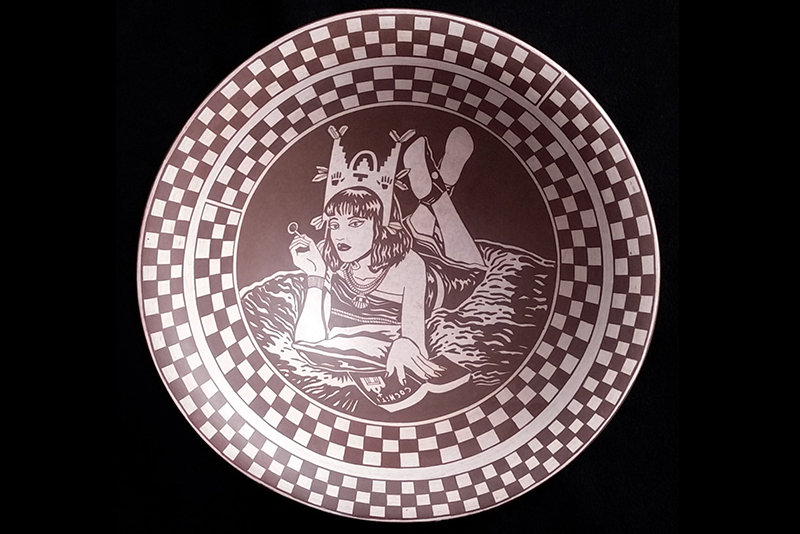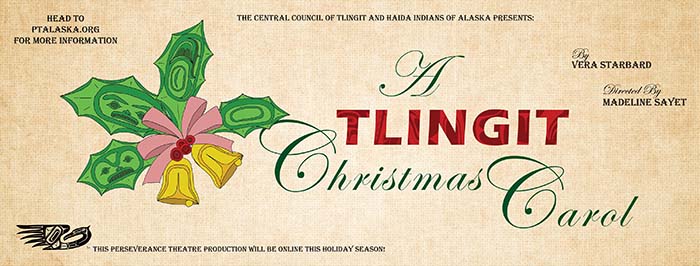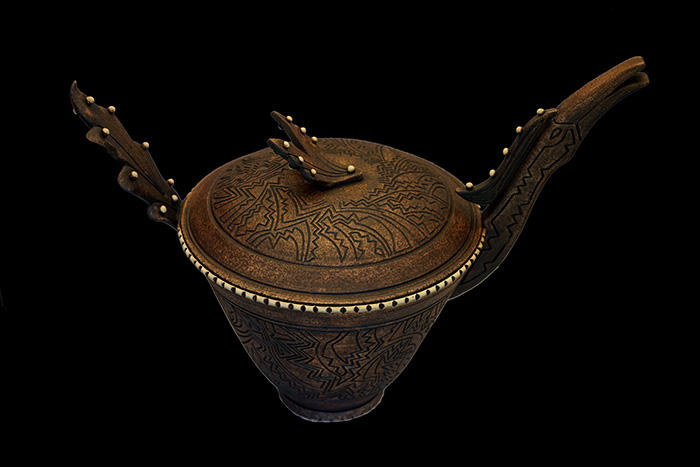
- Details
- By Tamara Ikenberg
This weekend and next week in Indian Country, you can check out Charles Dickens with a Tlingit twist, catch up with an influential Indigenous art duo out of the Southwest, and help keep the residents of a very chilly reservation warm this winter.
Allow Native News Online’s event roundup to assist you in your Indigenous event-planning.
Curator's Circle: Cara Romero & Diego Romero
WHEN: Thursday, December 3, 2 p.m. PST
WHERE: Register here.
He’s an eclectic Cochiti Pueblo ceramicist. She’s a contemporary Chemehuevi photographer.
Together, they’re one of the country’s coolest Indigenous art power couples.
Diego and Cara Romero will discuss their layered, culturally conscious work Thursday, Dec. 3 in an online Curator’s Circle session, presented by the Wheelwright Museum of the American Indian, themed “Laughter and Resilience: Humor in Native American Art.” The conversation will be led by the Wheelwright’s Chief Curator, Andrea R. Hanley (Navajo).
Humor and clever juxtapositions of Native and pop culture play prominent roles in each artist’s anti-colonial pieces.
For instance, In “Pueb Fiction,” Diego, who also incorporates Greek Anasazi, and Pueblo design elements into his pottery, recasts tragically hip “Pulp Fiction” heroine Mia Wallace as a Southwest Native-style gangster moll.
 "Water Memory" by Chemehuevi photographer Cara Romero. Romero and her husband Diego will participate in an online Curator's Circle discussion, presented by the Wheelwright Museum of the American Indian in Santa Fe, on Thursday, Dec. 3. (Cara Romero Photography)Diego Romero’s anti-colonial art has been shown at institutions including the Metropolitan Museum of Art in New York, the Peabody Essex Museum in Massachusetts, the Heard Museum in Phoenix, and the British Museum.
"Water Memory" by Chemehuevi photographer Cara Romero. Romero and her husband Diego will participate in an online Curator's Circle discussion, presented by the Wheelwright Museum of the American Indian in Santa Fe, on Thursday, Dec. 3. (Cara Romero Photography)Diego Romero’s anti-colonial art has been shown at institutions including the Metropolitan Museum of Art in New York, the Peabody Essex Museum in Massachusetts, the Heard Museum in Phoenix, and the British Museum.
In August, Vogue named Cara Romero one of “8 Artists to Know From This Year’s Virtual Santa Fe Indian Market,” and lauded her “arresting photographs rooted in current events and issues within the Indigenous community.”
Romero often tackles environmental and social issues, but she also gets playful with her approach to art.
“The Last Indian Market,” Romero’s Santa Fe-style send-up of “The Last Supper” features a who’s who of Native artists, including Diego and the iconic Santa Fe Buffalo Man, who roams through town like a mythological creature. Romero also enlisted the Buffalo Man for shoots referencing scenes from “The Graduate,” and intimate John Lennon and Yoko Ono photos.
Cara Romero is also the recipient of myriad awards and honors, including the Institute of American Indian Arts Distinguished Alumni Awards, and numerous top prizes in photography from major shows including the Heard Museum Indian Guild Indian Fair and Market and the Santa Fe Indian Market.
A Tlingit Christmas Carol
 Juneau, Alaska's Perseverance Theatre is presenting "A Tlingit Christmas Carol," by Tlingit, Dena'ina and Athabascan playwright Vera Starbard, in a series of online episodes on ptalaska.org. (Perseverance Theatre)
Juneau, Alaska's Perseverance Theatre is presenting "A Tlingit Christmas Carol," by Tlingit, Dena'ina and Athabascan playwright Vera Starbard, in a series of online episodes on ptalaska.org. (Perseverance Theatre)
WHEN: Friday, Dec. 4, Friday, Dec. 11, and Friday, Dec. 18 at 7 p.m., and Friday, Dec. 25, 10 a.m.
WHERE: Perseverance Theatre, and Perseverance Theatre’s YouTube.
What if Scrooge was a Tlingit businessman tormenting his toiling employees and coldly counting his cash in modern-day Southeast Alaska?
Juneau, Alaska’s Perseverance Theatre presents a free virtual vision of that alternate Dickensian reality in “A Tlingit Christmas Carol,” written by Vera Starbard, directed by Madeline Sayet, and featuring music composed by Ed Littlefield.
In this “Carol,” the sneering Scrooge is blocking his hardworking, unappreciated employees from properly celebrating Russian Orthodox Christmas.
The contemporary Tlingit twist on the Christmas classic, which weaves in coronavirus, Native Corporations and issues like balancing being Tlingit and Christian, is being released for free viewing in streamed episodes approximately 20 minutes each. The first episode is already posted.
All installments will be available on demand through Russian Orthodox Christmas, Jan. 7, 2021.
Redbird’s 25th Annual Blanket Drive and Gathering
WHEN: Saturday Dec. 5, 11 a.m. - 3 p.m.
WHERE: Simi Valley Town Center Mall, 1555 Simi Town Center Way, Simi Valley, Calif., More information: https://www.redbirdsvisions.org/
 Redbird’s 2020 Blanket Drive and Gathering supporting the residents of South Dakota's Oglala Sioux Pine Ridge Reservation, will take place on Saturday Dec. 5, at Simi Valley Town Center Mall in Simi Valley, Calif. (Redbird Visions)
Redbird’s 2020 Blanket Drive and Gathering supporting the residents of South Dakota's Oglala Sioux Pine Ridge Reservation, will take place on Saturday Dec. 5, at Simi Valley Town Center Mall in Simi Valley, Calif. (Redbird Visions)
Winters are cold and cruel in southwest South Dakota, where the Oglala Sioux Pine Ridge Indian Reservation is located.
At night, temperatures fall into the teens, and during the day it rarely gets above freezing. And many of the reservation’s residents lack the resources to keep themselves warm, healthy and comfortable.
Providing what Pine Ridge’s people need to stay toasty through the frigid season is the aim of the annual Blanket Drive and Gathering hosted by Redbird, a California-based Native American and environmental nonprofit.
This year, the event will be part live and part online. New, easily washable blankets, warm clothing and new or like-new winter gear, like ski clothing, are what Redbird needs.
Those who wish to donate can drop items off at the Simi Valley Town Center Mall in Simi Valley, Calif. on Saturday, Dec. 5, or purchase through Amazon, using Redbird’s Amazon Smile wish list.
Redbird is also accepting cash donations to cover shipping costs via PayPal. Donation checks can be sent to Redbird, P.O. Box 702, Simi Valley, CA 93062.
Redbird sends the clothes and blankets to the White Plume family of Manderson, S.D., who bring them to the reservation for distribution.
Cherokee Art Market
WHEN: Monday, Dec. 7, 7 a.m. - Monday, Dec. 21, 7 a.m.
WHERE: http://www.CherokeeArtMarket.com/
Every December, Oklahoma becomes the focal point of Indigenous art, when the creme de la creme of creatives and connoisseurs flock to Tulsa’s Hard Rock Cafe for the Cherokee Art Market, which customarily features the work of more than 125 elite Indigenous artists and artisans representing 50 different tribes.
In this year when flocking is forbidden, Cherokee Art Market is moving online for a deluxe two-week shopping opportunity brimming with jewelry, pottery, textiles, paintings, sculptures and more.

Featured artists include master sculptor and Cherokee National Treasure Troy Jackson, whose Cherokee veterans memorial sculpture "The Soldier was Wounded in War," was recently installed in Tahlequah, Okla., basketmaker and Cherokee National Treasure Vivian Cottrell, Arapaho and Seneca multi-disciplinary artist Dallin Maybee, who produces pop-art gas masks, and Jemez Pueblo sculptor Kathleen Wall, who molds and paints pretty, highly-detailed clay Hopi maidens proudly presenting their own beautiful mini-baskets.
More Stories Like This
A Native American Heritage Month Playlist You Can Listen to All Year Long11 Native Actors You Should Know
Five Native American Films You Should Watch This Thanksgiving Weekend
Heavy metal is healing teens on the Blackfeet Nation
Over 150 Tribal Museums Participate in Fourth Annual Celebration of Native Life
Help us defend tribal sovereignty.
At Native News Online, our mission is rooted in telling the stories that strengthen sovereignty and uplift Indigenous voices — not just at year’s end, but every single day.
Because of your generosity last year, we were able to keep our reporters on the ground in tribal communities, at national gatherings and in the halls of Congress — covering the issues that matter most to Indian Country: sovereignty, culture, education, health and economic opportunity.
That support sustained us through a tough year in 2025. Now, as we look to the year ahead, we need your help right now to ensure warrior journalism remains strong — reporting that defends tribal sovereignty, amplifies Native truth, and holds power accountable.
 The stakes couldn't be higher. Your support keeps Native voices heard, Native stories told and Native sovereignty defended.
The stakes couldn't be higher. Your support keeps Native voices heard, Native stories told and Native sovereignty defended.
Stand with Warrior Journalism today.
Levi Rickert (Potawatomi), Editor & Publisher

